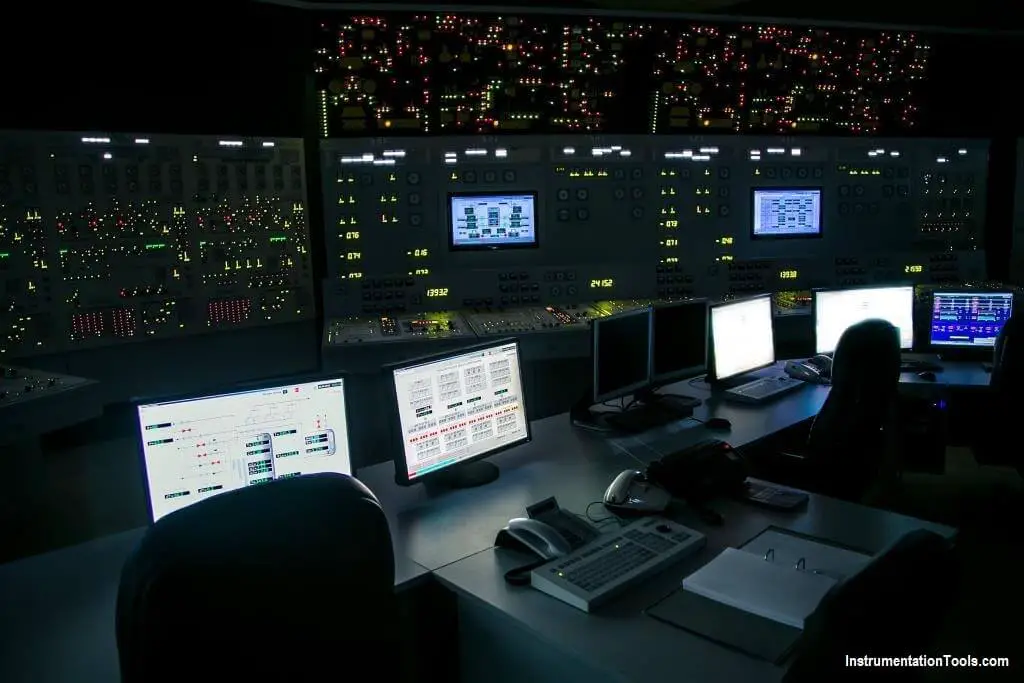We provide you the latest 100 multiple choice questions and answers on industrial automation and control for instrumentation engineers.

Find the sample 10 questions from the industrial automation and control quiz. Click on the below start button to get complete 100+ questions with answers.
The level in a water collection tank is being controlled by an automatic level controller that positions a tank drain valve.
The tank level is initially stable at the controller setpoint.
Then, the flow rate into the tank increases, slowly at first, and then faster until a stable flow rate is attained.
When the tank level increases, the controller begins to open the tank drain valve farther.
The level controller output signal increases both as the tank level increases and as the rate of the tank level change quickens.
After a few minutes, a new stable tank level above the original level is established, with the drain flow rate equal to the supply flow rate.
The controller in this system uses __________ control.
A) proportional plus integral plus derivative
B) proportional only
C) proportional plus derivative
D) proportional plus integral
Which one of the following describes a characteristic of pneumatic valve positioners?
A) They act independently of the valve controller, in order to prevent pressure transients on the valve actuator diaphragm.
B) They supply air pressure to valve actuators in response to a control signal to regulate valve position.
C) They provide auto and manual demand signals to valve controllers and valve actuators.
D) They can either receive or supply air to/from valve controllers, depending on the direction of valve travel.
An automatic flow controller is being used to position a valve in a cooling water system.
A signal that is proportional to the valve position is received by the controller. This signal is referred to as
A) bias.
B) error.
C) feedback.
D) gain.
The difference between the setpoint in an automatic controller and the steady-state value of the controlled parameter is called
A) feedback.
B) deadband.
C) gain.
D) offset.
A flow controller has a proportional, integral, and derivative control features.
Which one of the following lists the effect on the control features when the controller is switched from the automatic mode to the manual mode?
A) All control features will continue to influence the controller output.
B) All proportional, integral, and derivative features will be lost.
C) Only the integral and derivative features will be lost.
D) Only the derivative feature will be lost.
If the turbine shaft speed signal received by a typical turbine governor control system fails low during turbine startup, the turbine governor will cause turbine speed to.
A) decrease to a minimum speed setpoint
B) increase until the mismatch with demanded turbine speed is nulled.
C) increase until an upper limit is reached or the turbine trips on Overspeed.
D) decrease until the mismatch with demanded turbine speed is nulled
The level in a tank is controlled by an automatic control system.
The level is initially at its setpoint.
A drain valve is then opened, causing the tank level to begin to decrease.
The decreasing level causes the controller to begin to open a makeup supply valve.
After a few minutes, with the drain valve still open, the level is again constant at the setpoint.
The controller in this system uses primarily __________ control.
A) proportional
B) on-off
C) integral
D) derivative
The range of values around the setpoint of a measured variable where no action occurs in an automatic flow controller is called
A) deadband.
B) error.
C) deviation.
D) bias.
A valve controller logic diagram.
Which one of the following combinations of inputs will result in the valve receiving a CLOSE signal?
A) 1-On 2-On 3-On 4- Off
B) 1-Off 2-Off 3-On 4-Off
C) 1-On 2-Off 3-Off 4-On
D) 1-On 2-On 3-Off 4-Off
An automatic flow controller is being used to position a valve in a cooling water system.
The controller develops a flow error signal and then increases the magnitude of the signal to drive the valve operator.
The factor by which the magnitude of the flow error signal is increased is referred to as
A) gain.
B) bias.
C) offset.
D) feedback.
Click on the below button to launch the Quiz.
Answers available in the Quiz.
The conveyor sorting machine is widely used in the packing industries using the PLC program…
Learn the example of flip-flop PLC program for lamps application using the ladder logic to…
In this article, you will learn the STAR DELTA programming using PLC controller to start…
Lube oil consoles of rotary equipment packages in industrial process plants are usually equipped with…
Rotating equipment packages such as pumps, compressors, turbines need the lube oil consoles for their…
This article explains how to blink lights in ladder logic with a detailed explanation video…
View Comments
Can i get this in .exe for archives?